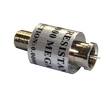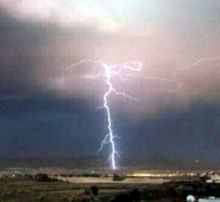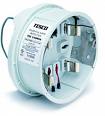 An analysis commissioned by State Farm Insurance found of 5500 detailed claims, more than half of the loss was related to telephone and electronic appliances.
An analysis commissioned by State Farm Insurance found of 5500 detailed claims, more than half of the loss was related to telephone and electronic appliances.
As we become more connected through smart technology, AC power and low voltage or non-voltage carrying conductors become intertwined through the technology. When you think about it, more and more devices have an AC power cord and a communications port for the transmission/reception of an external signal (video, DSL, etc.). Known as “multi-port” equipment (AV Receivers, TV’s Modems, Computers, etc.) these devices add complexity to the transient voltage issue by creating additional doorways into the equipment. As we saw in the AC Ground and Bonding article, external surges can enter the house as easily through the Telephone line, CATV or Satellite Dish as the AC utility. Studies show, even with a TVSS in the AC circuit, micro-electronics embedded in the equipment have failed due to transient voltages passing through the communications link. According to the same insurance study mentioned above, equipment including micro-electronics such as computers, TV’s, VCR’s and Satellite receivers recorded more significant losses than single-port equipment. This is not news to most of us. However, the point to recognize here is that any incoming services that arrive inside the house on a current carrying conductor (copper wire) has the potential to allow a voltage surge into the house and into our electronic equipment.
To make matters worse, having proper surge protection on the AC service and not on non-power related services may actually enhance the opportunity for a fault to occur in the multi-port equipment through surge current. This surge current can create a voltage shift at the secondary-port on the equipment producing damage in the equipment. This voltage shift condition can also be rooted to a difference in voltage potential or ground reference at (you guessed it) the service entrance ground. This is the reason why we have seen more emphasis from the standards bodies (National Electric Code and National Institute of Standards Institute) on the common grounding and bonding of all the incoming services (Telephone, CATV and Satellite TV) found in a typical residence. For this reason, in 1992 the IEEE recognized this potential fault condition and coined the term Surge Reference Equalizer. Even though the industry has not really picked up on the term nor have they created a specific standard, the UL1449 listing for this Class B surge protectors is acceptable for the time being.
Proper Bonding and Grounding Remain the Key Contributor to Both the Problem and the Solution
If you have read the four articles up to this point, you may think I am beating this subject to death, but grounding/bonding remains the key contributor to both the problem and the solution. Complete the 8 point check list found in the AC Service Bond and Ground Part II. If your house is less than 10 years old, it would be a fair assumption that all the incoming services enter near or at the AC service meter. Assuming all the services are bonded correctly as mentioned, you should be in good shape with the Telephone and CATV. For the rest of us, these services could attach any where around the house this also includes Satellite TV Antennas. If possible, bringing all of these services within 20 feet of the AC Service entrance and attaching them as mentioned will assist in improving the ground system. (TIP: Satellite installations are typically located where they provide the best signal, bringing the ground termination from AC service entrance is important here as well).
Surge Reference Equalizer
 At this point, we will assume that you have a good common ground with an equal ground reference. With that said you have successfully reduced the risk to multi-port equipment, BUT, both the IEEE and the NIST support the use of the Surge Reference Equalizer. As pictured, it looks like a typical Class B surge protector, but also has ports for communications ( RJ45 terminal, and threaded CATV terminal. With this type of TVSS there will be a PORT-IN and PORT-OUT set of connections. Consider a Class B surge protector that includes both communication ports and CATV connections collectively in the same product for home theater equipment, set top boxes, satellite equipment, computers and any other mutli-port electrical equipment.
At this point, we will assume that you have a good common ground with an equal ground reference. With that said you have successfully reduced the risk to multi-port equipment, BUT, both the IEEE and the NIST support the use of the Surge Reference Equalizer. As pictured, it looks like a typical Class B surge protector, but also has ports for communications ( RJ45 terminal, and threaded CATV terminal. With this type of TVSS there will be a PORT-IN and PORT-OUT set of connections. Consider a Class B surge protector that includes both communication ports and CATV connections collectively in the same product for home theater equipment, set top boxes, satellite equipment, computers and any other mutli-port electrical equipment.
Additionally Square D has release a whole house model that includes a Class C surge protector and the connections for Telco and CATV services. Tiered protection is still recommended if you decide to follow the whole house approach. (Square D Model SDSB1175C). NOTE: This method of reference equalizer is fairly new as previous practices supported keeping the services segregated until the point of termination, (CATV, Phone) independently until they reach the point of use or the device that is common (i.e. TV, PC). As you will note, that is how I built my system. This is still an acceptable solution.
Additional Choices – Surge Protection for Communication, CATV and Satellite:
Telephone Service: Most wire-line telephone service companies provide surge protection. If your telephone service was installed less  than 10 years ago or has been worked on in that time frame you will probably have a NID (Network Interface Device) at the telephone entrance. Telephone companies typically use “Gas filled arrestors”. Even though you may not have a NID, you probably have gas arrestors if your phone has been serviced in the last 20 years. Gas arrestors replace Carbon arrestors as the gas style will defeat the surge without a long term loss in service as they will self restore automatically. Since I built my grounding system before the Surge Reference Equalizer was readily available, I placed an additional surge suppresor on my telephone line (Channel Vision C-0410). Much like the Telco provided unit it will disconnect the line in the event of a surge then restore it momentarily. Based on the performance characteristics of a Surge Reference Equalizer (SRE), in theory, I may still have a fault occur if my ground reference is not equalized and my Category A, B and C surge protectors are unable to defeat the surge prior to entering any of the protected equipment. Since the current UL1449 is the only published document and it seems to favor an AC type failure, for now, I am staying with my current system architecture using the C-0410 surge protection. TIP: You may have communications and/or video services provided by fiber optics. They will not have surge protection as optical services are unable to carry voltage or surge current. If you are unsure if you have fiber optic services, the NID will have a consumer replaceable battery pack that you were informed about during the installation of the services.
than 10 years ago or has been worked on in that time frame you will probably have a NID (Network Interface Device) at the telephone entrance. Telephone companies typically use “Gas filled arrestors”. Even though you may not have a NID, you probably have gas arrestors if your phone has been serviced in the last 20 years. Gas arrestors replace Carbon arrestors as the gas style will defeat the surge without a long term loss in service as they will self restore automatically. Since I built my grounding system before the Surge Reference Equalizer was readily available, I placed an additional surge suppresor on my telephone line (Channel Vision C-0410). Much like the Telco provided unit it will disconnect the line in the event of a surge then restore it momentarily. Based on the performance characteristics of a Surge Reference Equalizer (SRE), in theory, I may still have a fault occur if my ground reference is not equalized and my Category A, B and C surge protectors are unable to defeat the surge prior to entering any of the protected equipment. Since the current UL1449 is the only published document and it seems to favor an AC type failure, for now, I am staying with my current system architecture using the C-0410 surge protection. TIP: You may have communications and/or video services provided by fiber optics. They will not have surge protection as optical services are unable to carry voltage or surge current. If you are unsure if you have fiber optic services, the NID will have a consumer replaceable battery pack that you were informed about during the installation of the services.
 CATV and Satillite Services:In practice, the gas style arrestor is used in these services as well. Because they use coax as a cable medium the arrestor looks a little different but perform in a similar fashion as the communications arrestor.
CATV and Satillite Services:In practice, the gas style arrestor is used in these services as well. Because they use coax as a cable medium the arrestor looks a little different but perform in a similar fashion as the communications arrestor.
Theory vs. Science
One of the difficulties with this subject is it is very difficult to test your solution. To replicate a surge equivalent to a lightning strike is not feasible nor recommended. For this reason, surge protection, TVSS’s, SPD’s and bonding and grounding is not as black and white as we would like it to be and neither are the solutions. As you have seen in this article , there may be multiple solutions to the methods I have described. But overall, the method should still retain the same theme. I have engineered large systems in multi story buildings and spent hundreds of thousands of dollars (not mine) to create the right grounding network and still had recordable faults, so don’t think you will ever be 100% protected.
One of the best articles written to date for residential bonding/grounding and surge protection is “Surges Happen” produced by the Institute of Standards and Technology. This article covers the topic in very simple language and easy to understand instructions.
If you haven’t already, you may also want to read my 4 previous articles; AC Ground and Bonding, Electrical Switches and Outlets, AC Service Bond and Ground Part II, Residential AC Surge Protectors,
Key Inspection Points and Action Items:
- Annually check all your TVSS devices to insure the they remain in the protected mode (LED indicator).
- Follow the inspection routines as defined in AC Service Ground and Bonding Network by inspecting the mechanical connections and terminations.
In writing this series, it became apparent that I could not cover the subject in 1 or 2 postings. I hope I kept your attention and it made sense. Feel free to comment or send specific questions to Homeownerbob@gmail.com




 Posted by homeownerbob
Posted by homeownerbob 

 Excessive Demand on the Circuit: Most standard residential electrical circuits are wired in a series where the circuit wires loop through the electrical box, terminate on the outlet, then continue on to the next outlet. In other words, the electrical current being used by one outlet (on the same circuit) may pass through terminations of another receptacle. If the current is excessive, the outlet may be warm without anything attached at the receptacle. As part of an electrical design, it is normal to have at least one outlet in the same room to be on a different circuit. This allows you to share the load requirement from one room into multiple electrical circuits.
Excessive Demand on the Circuit: Most standard residential electrical circuits are wired in a series where the circuit wires loop through the electrical box, terminate on the outlet, then continue on to the next outlet. In other words, the electrical current being used by one outlet (on the same circuit) may pass through terminations of another receptacle. If the current is excessive, the outlet may be warm without anything attached at the receptacle. As part of an electrical design, it is normal to have at least one outlet in the same room to be on a different circuit. This allows you to share the load requirement from one room into multiple electrical circuits.





 We recently picked up the swag lamp pictured to the side. The picture is from the location we bought it. As you can see it was working. So why would I want to take it apart? Just to check it out! So, I disassembled it to clean, inspect, repaint the metal surfaces and total rewire if required. As with most any hanging type fixture with the bulb below the socket, there is a natural tendency for the rising heat to make an impact on the above wiring. As expected, I found brittle and decayed wiring above the socket. After seeing the condition of the wiring I wondered why the fixture was working at all! Overheated wiring is the sleeping giant of lamp and light problems. Most wiring is rated at 105C (or 221F), and in most correct applications will be fine, however when a bulb wattage is greater than the lamp rating is used, the wiring will be the first component to suffer. You may never know it until the wiring is disturbed. Once disturbed, the insulation can disintegrate and potentially cause the wires to touch each other. You know where the story
We recently picked up the swag lamp pictured to the side. The picture is from the location we bought it. As you can see it was working. So why would I want to take it apart? Just to check it out! So, I disassembled it to clean, inspect, repaint the metal surfaces and total rewire if required. As with most any hanging type fixture with the bulb below the socket, there is a natural tendency for the rising heat to make an impact on the above wiring. As expected, I found brittle and decayed wiring above the socket. After seeing the condition of the wiring I wondered why the fixture was working at all! Overheated wiring is the sleeping giant of lamp and light problems. Most wiring is rated at 105C (or 221F), and in most correct applications will be fine, however when a bulb wattage is greater than the lamp rating is used, the wiring will be the first component to suffer. You may never know it until the wiring is disturbed. Once disturbed, the insulation can disintegrate and potentially cause the wires to touch each other. You know where the story  goes from here. Always follow the bulb ratings requirements as listed on the fixture.
goes from here. Always follow the bulb ratings requirements as listed on the fixture. Wiring terminations: Most failed wiring is at the terminations. Frayed/broken wires, premature insulation failure, loose connection can all impact the safety and performance of the light. In this picture the bottom wire has decayed insulation and has turned black in color due to excessive heat. The one on top is in good condition.
Wiring terminations: Most failed wiring is at the terminations. Frayed/broken wires, premature insulation failure, loose connection can all impact the safety and performance of the light. In this picture the bottom wire has decayed insulation and has turned black in color due to excessive heat. The one on top is in good condition. Ventilation: As you can see in this picture of the top cap of the same swag lamp; there is virtually no ventilation for the heat to escape. Just for safety sake, I added some ventilation holes in the top cover.
Ventilation: As you can see in this picture of the top cap of the same swag lamp; there is virtually no ventilation for the heat to escape. Just for safety sake, I added some ventilation holes in the top cover.




 are still considered acceptable. However, proper grounding for today’s electronics may not be compatible and rewiring your house may be considered.
are still considered acceptable. However, proper grounding for today’s electronics may not be compatible and rewiring your house may be considered.  different and should be labeled as such and will have a self test button. The test button should disable the outlet and expose a reset light or button. Press the reset button and power should be restored. If the outlet does not disable and reset during the test, it should be replaced. In some cases, GFI outlets may be wired together and will cause multiple outlets to be disabled at the same time. TIP: These additional outlets may look like regular outlets but SHOULD be labeled as GFI, but don’t be surprised if they are not. Additionally the controlling GFI outlet may or may not be located in the same room.
different and should be labeled as such and will have a self test button. The test button should disable the outlet and expose a reset light or button. Press the reset button and power should be restored. If the outlet does not disable and reset during the test, it should be replaced. In some cases, GFI outlets may be wired together and will cause multiple outlets to be disabled at the same time. TIP: These additional outlets may look like regular outlets but SHOULD be labeled as GFI, but don’t be surprised if they are not. Additionally the controlling GFI outlet may or may not be located in the same room.












